An action selection, worker placement game where players colonize Mars
120 minutes
Designer: Vital Lacerda
Artist: Ian O'Toole
Publisher: Eagle-Gryphon Games
On Mars is a game that had us drooling just from the cover art. Throw in an overwhelming board and a rulebook that could be used as a bedtime story, and we were all in.
While this isn’t a game for the faint of heart, we were surprised and delighted to find it was way more approachable than it seems at first glance. Once we struggled through the first game or two, the challenges and strategies we faced were super fun and easily launched this game into our top 20.
Gameplay Overview
This is a general overview to provide context for the review, not an in-depth how to play. Some rules are definitely glossed over or missing so you don’t have to read eight pages in a blog. We always have this disclaimer, but this is ESPECIALLY true for On Mars.
Game Flow
The game is played over a variable number of rounds, with a few ways to trigger game end. Each round consists of two phases: Colonization (do actions) and Shuttle Phase (travel between Mars and Orbit).
On Mars has a variable round length – as the game progresses and turns become more complex, the rounds themselves get longer with more actions. The different game-end triggers (rather than a set number of rounds) also mean players have some control over the length of the game through the choices they make.
Concept: Colonization and Shuttle Phases
The core thematic concept of the game is that players are traveling back and forth between an orbital station (the left side of the board) and the colony on the surface of Mars (right side of the board). Each side has different actions that fit into the theme:
- Orbit: get resources and technology to bring to the surface
- Surface of Mars: use resources to build, expand, and improve upon the Mars colony
The round begins with the Colonization Phase. During this phase you may take one main action each turn and up to one executive action. The main actions available to you in a round depend on which side of the board your player marker is on. When your player marker is in orbit, orbital station actions are available. And likewise, when your player marker is on the colony side, the colony actions are available.
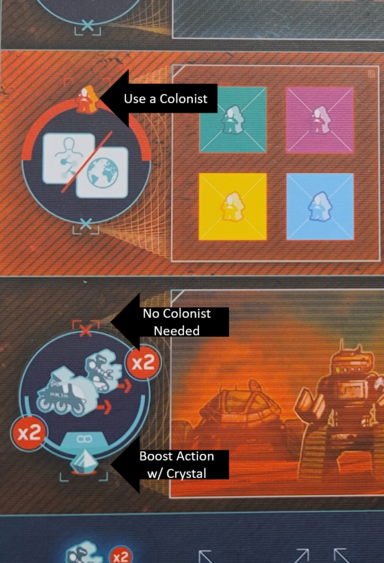
Colonization Phase: Actions
Okay, but how do you actually do an action? This is where the excellent iconography on the board is super handy.
Each side of the board (orbit and colony) has unique action spaces. Some require you to send an available colonist (worker) from your player mat, while others are “free”. Some action spaces can be “boosted” by crystals or additional colonists. The iconography at each action space tells you what you can do so you don’t have to remember.
Pro Tip: Boosting an action is a powerful way to get more out of a single turn, but colonists are limited and crystals are tough to come by so it can also be very expensive.
Orbital Station Actions
- Landing Pod – Take the pod back down to the colony (try not to use this unless desperate).
- Obtain Blueprint – Take an available blueprint from the display. Immediately gain the resource benefit shown. This can later be developed into an advanced building.
- Learn New Technology – Take a tech tile and place it onto your player board. Get an immediate benefit of anything covered up.
- Research and Development (R&D) – Develop 1-2 tech tiles by moving them right on your player board and paying the associated cost.
- Resupply – Take a resource or crystal from the warehouse.
Colony Actions
- Control Center – Move your bots & rover up to 2 spaces on the map.
- Bots – Cleaners and builders
- Cleaning – Remove Discovery & Research tiles from game. Remove Crystals from map.
- Building – players can only build buildings (see below) on hexes adjacent to (or under) a bot, so think carefully about bot placement!
- Rover – Collectors
- Use Rover to collect crystals, Discovery tiles, and Research tiles from the map.
- Gain immediate benefits from Research and Discovery tiles.
- Use Rover to collect crystals, Discovery tiles, and Research tiles from the map.
- Bots – Cleaners and builders
- Construct a Building – Pay the resource cost and follow placement rules to construct one of the Life Support System (LSS) buildings or a shelter. Gain the resource of the type of building constructed.
- Placement: Building must either be placed adjacent to another building of the same type to create a complex (must have tech) or exactly two hexes away from a building of the same type (does not require tech).
- Types of Buildings:
- Shelter
- Oxygen Condenser
- Greenhouse
- Water Extractor
- Generator
- Mine
- Increase building marker level on the LSS, check to see if the colony is ready to level up.
- Upgrade a Building – pay a mineral to develop a blueprint into an advanced building.
- Advanced buildings produce resources when leaving the colony to orbit in the Shuttle Phase.
- Welcome a Ship – pay 1 water and 1 plant to move a ship marker from the depot on your player mat into the hanger on your player mat (see gif).
- Get additional colonists and/or bot.
- Unlocks additional executive actions.
- Hire a Scientist/Take Earth Contract – Take a Scientist (points/executive actions) or an Earth Contract (points).
Note: We’ve found that one key to a good game is making sure your blueprints, advanced buildings, scientists, and earth contracts all work together. They don’t quite make an “engine”, but they can chain off each other, especially for end game scoring. Make sure you pay attention to what’s available, and what your opponents might want!
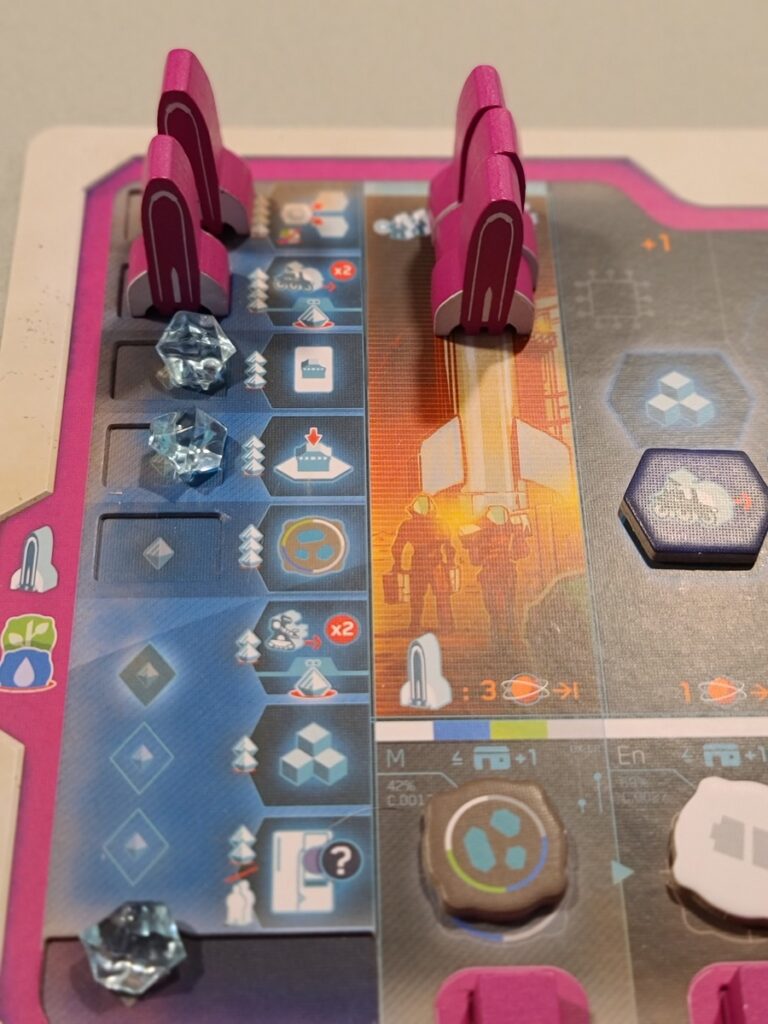
But Wait! There's More...Executive Actions
Executive actions can be taken once per turn, either before or after the main action. At the beginning of the game, there are only a few available, but more will be “unlocked” when you welcome a ship (see above).
Basically, executive actions are expensive versions of the main actions, but they are CRITICAL to a high-scoring game. This is mainly because they increase the number of things you can do in a single turn and they can give you access to actions that are on the other side of the board.
An executive action is also the only way to take advantage of the benefits of your advanced buildings, some of which are super powerful. By mid-game it’s a good idea to have an advanced building or two that you can optionally activate on your turn in addition to a main action. Even better if you have a scientist, which means you don’t have to pay crystals for it (essentially a super powerful FREE action).
Note: The executive action spaces are also where your crystals are stored at the end of each turn – not enough spaces? Lose the excess crystals. This hurts, so plan accordingly.
Shuttle Phase
Still with us? After that information overload, let’s remind ourselves that you can only do the actions from the side of the board your player marker is on. How do you get to the other side you ask? Most commonly, you’ll travel on the shuttle during the shuttle phase!
Orbit to Colony – perform the following actions in turn order ONLY if you are moving.
- Place Discovery Tile 3 spaces away from your Rover on the colony map.
- Collect your colonists on action spaces from the colony side of the main board (where you are headed), return colonists in the working area of the player board to living quarters.
- Select turn order position and benefit.
Colony to Orbit – perform the following actions in turn order ONLY if you are moving.
- Collect resources from your advanced buildings and mines on the colony map (Produce).
- Retrieve your colonists from the orbit side of the main board (where you are headed), return colonists in the working area of the player board to living quarters.
End of Game
Fun fact: there’s still more!
We mentioned before that the game doesn’t have a set number of rounds. Instead, there are end game triggers. During setup, you randomly select 3 goal cards (typically 2 short, 1 long) that players collectively are trying to complete. One game end trigger is to complete all three goals. Another game end trigger is to build enough buildings that the LSS gets to level 5. It’s also possible (and common) to end the game with some combination of LSS + goals.
At the end, you get points for having built complexes (>1 connected building of the same type), welcomed ships, workers, completed blueprints, scientists, and completed Earth contracts.
Note: incomplete blueprints and Earth contracts are negative points! Also note – Scientists score points for ALL advanced buildings of a given type, even your opponent’s buildings.
What do we think?
Phew! There’s a lot going on in On Mars, and we didn’t even touch on everything or go into all the detail. But that’s part of what we love about this game: there’s a million paths to victory. Do you focus your energy on expansion? Do you turn your attention to a ton of upgrades? Do you diversify or go all-in on one or two building types? How do you respond to what other players are doing? Where will the bulk of your points come from at the end?
These questions are what keep us up at night, and we often find ourselves discussing our decisions well after finishing up a game of On Mars. It’s a tough game to play, but somehow we keep bringing it to the table over and over. To us, that’s the secret sauce of On Mars – it hurts your brain, but we always want to come back for more.
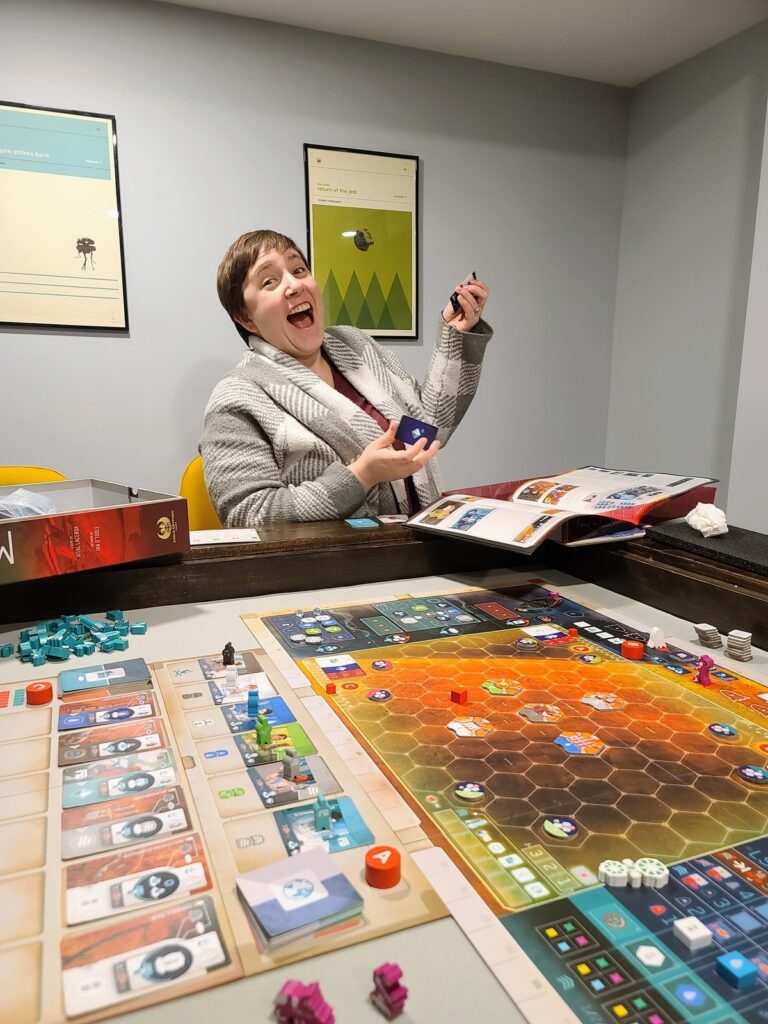
What did we like?
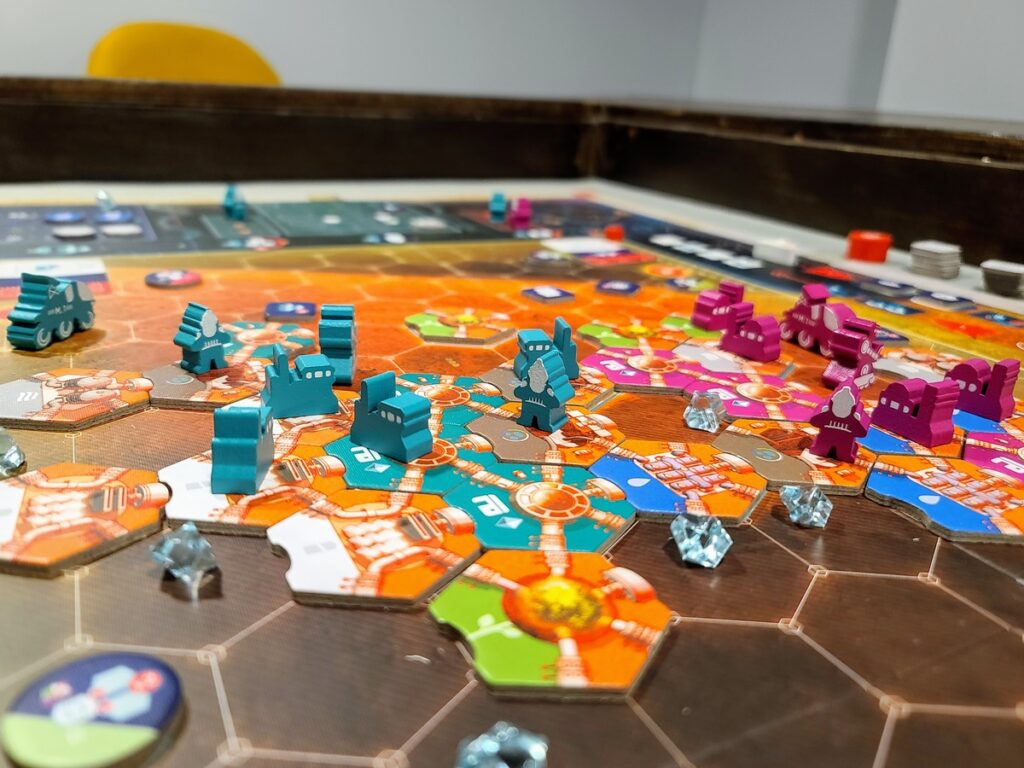
We’ve played about five or six times now, and each time gets better (but not faster). There is great re-playability since it’s good to adjust your strategy based on goal cards, blueprints, etc that change during set up from game to game. The million strategies also give you a lot of things to try.
What’s especially great about this game for us is how good it is at 2-player. There are very few scaling changes for 2 players, and yet the game doesn’t really need it. There’s plenty of tension for us and the unique action space activation mechanisms make it already pretty tense at 2 and wouldn’t change a ton at higher player counts. The only thing that would feel very different at higher counts is the map. We tend not to be very combative players, so having a bit less interaction at 2 on the central map is actually a benefit in our eyes.
This isn’t really an engine building game, but it does have actions that build and chain together beautifully to give you that “engine building” feel. The game is designed thoughtfully so that there are a lot of pieces you can fit together in unique ways to eventually get that high score.
We also love pointing out when the theme integration is spot-on, and On Mars should be held up as a standard for how to integrate theme with heavy strategic concepts. The mechanics of the game are purposefully aligned with the theme and they all make sense. Along with the theme, the artwork is incredible and the iconography makes an otherwise overwhelming game a LOT more approachable.
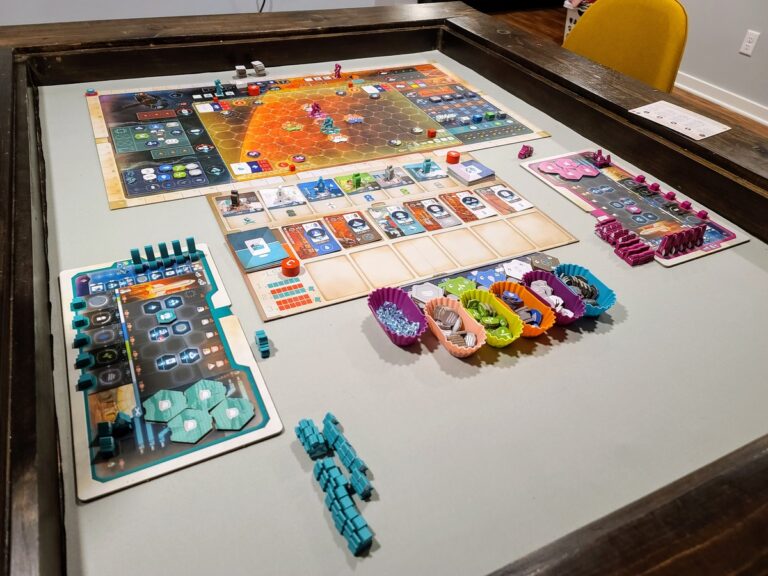
What didn't we like?
This is a LONG game for us. Like all games where we have some control over the length, we both have that initial instinct to draw it out to score as high as possible, regardless of whether that’s the best strategy. We’re working on it.
There’s also a pretty high barrier to entry, especially for newer board gamers who aren’t as familiar with games in this weight class. We can easily see some people getting stressed out over the nuances and subtle rules and that can definitely impact how enjoyable a game is. For us, the first 2 (or 3) games were definitely learning games where we knew we weren’t playing our best, and we definitely kept messing up a rule or two. It took until the third or fourth play to really feel like we were getting it. That might turn some people off, especially when it’s such a time commitment already.
Who will like this game?
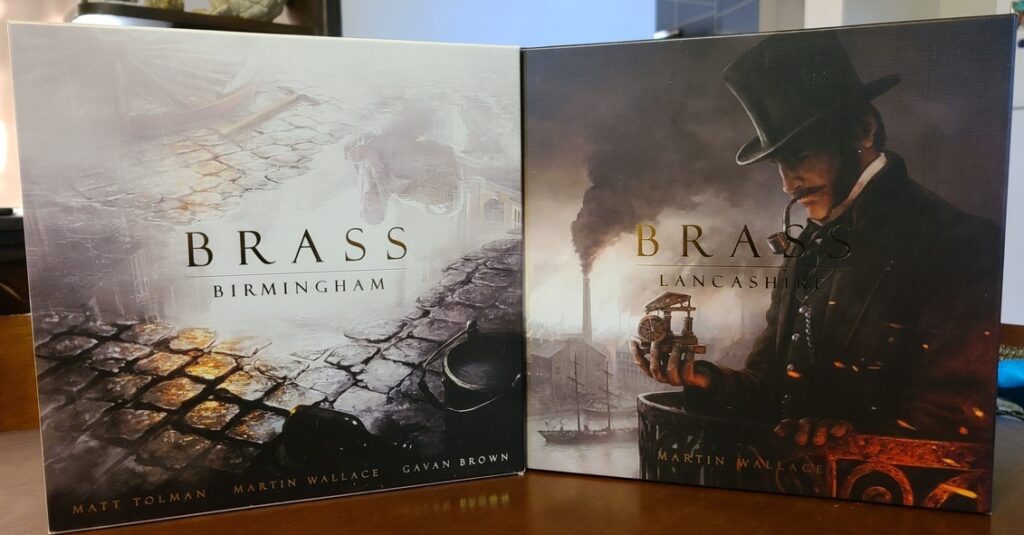
This is definitely a great fit for experienced gamers, but we think this also might be one of the better games for less experienced board gamers interested in moving into heavy games. The iconography and player aid are both great which helps players keep track of the rules and the many options. There is also some forgiveness for mistakes, meaning if you make a bad decision early in the game you can recover later.
People who like a Lacerda game often like most or all Lacerda games, and this one is no exception.
Outside of the world of Lacerda (Lacerdaville?), folks who like games like Trickerion or Brass: Birmingham (review [HERE]) might like On Mars. To some extent this can also feel a bit like a sandbox game similar to Feast for Odin, where you have many possible choices each turn, each with their own positive/negative consequences.
Sarah's Take
Oh On Mars. I have a love-hate relationship with this game. I like the idea of it. I have tons of fun playing it once we get going, but I am bad at it. I’m probably bad at it because it always takes me a few turns or so to really remember everything that I can do on a turn.
As we mentioned a time or two, there are a lot of things you can do in this game! And, to my detriment, I like to do a bit of everything. There are some games (Brass) where I have laser focus on my plan and am disciplined on sticking to it. But here, I just want to do things! And the game lets me! It’s definitely an improvement I need to focus on while playing On Mars. (Don’t be like me, focus on a 2-3 things max until you really understand how everything interacts).
On Mars is a game that I think about strategies and plans to try when we are not playing. It’s a game I know I want to revisit and that’s super exciting to me.
Emily's Take
Winning a game like On Mars is incredibly satisfying, and part of what I love about this game is that I keep kicking Sarah’s butt. It probably took me 3 games or so to really understand how to best string together the different elements into a cohesive strategy. At first I just kind of did everything, but after a few games it became a super fun challenge to figure out the best moves.
It’s a long, involved game though so we can’t play it super often with the kiddos around. That’s why I appreciate the iconography and the player aide so much. It’s impossible to remember all the rules if there are several months in between plays, so we’ll always need a refresher and the great iconography helps a lot.
Breakdown
Rulebook / Learning the game
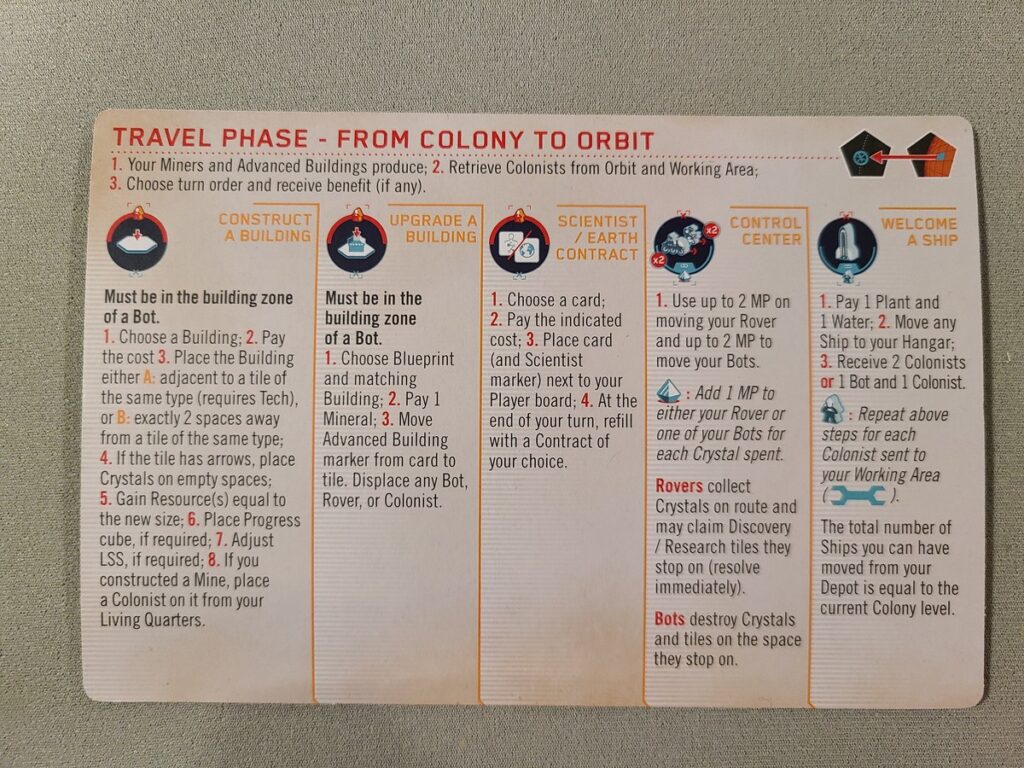
For our learning game we followed along with Paul Grogan’s How to Play video. His video is well organized and extremely easy to follow.
The actual rulebook is also super well organized. There was enough time between a few of our plays that we needed a rules refresher, and the rulebook was pretty easy to navigate. There is also a pretty good reference guide and a player aide that help a lot too.
First Play
Our first play was definitely a learning game and the learning curve was steep. Since neither of us had ever played, we overlooked a rule or two and didn’t realize until later.
We also ended up doing a “learning night” where we basically just figured out the setup and played a few rounds. That itself took about 2 hours (with kid interruptions). The next night we played an actual first game.
Subsequent Plays
On Mars is definitely not a game you want to leave a big time gap between playing for the first time and subsequent plays (yes, we are speaking from experience here). Despite how good the rulebook and the iconography and everything is, it would have been much easier on us if we had played a few times in a shorter period to better get the hang of it. The way we did it with a bit over a month in between, we basically had to re-learn from scratch the second full play through.
This is a game that gets better with each play. As we settled into a better and better understanding of the rules, we could figure out the best strategies for the various scenarios. For us, On Mars is super re-playable now that we have a good handle on the rules, especially given it’s not one that’s easy to get to the table frequently.
Parent Perspective
Interruptions
On Mars is a game with a complex action chain where each action taken is consequential. That makes it fairly difficult to step away when your kiddo NEEDS you to identify every dinosaur in their new 20-pack of Jurassic World figurines or he can’t possibly be expected to sleep.
There’s also a lot hinging on reacting to your opponents’ actions. You will definitely need to adjust your strategy at some point based on their decisions, so it’s tough to let them take a turn while you go put your kid’s blanket back on after he started crying because he kicked it off. Tough life.
Time Investment
For us, On Mars is a solid 2-2.5 hour investment. Set up and clean up can be a chore.
Also, the insert is super helpful, BUT it’s a bit annoying that it’s not made to take out/put back in the box. Everything has its place, so it should have been relatively easy to make the resource tray separate so you can just pop it in/out when setting up and cleaning up to make it faster. You could do that, but it’s a weird shape and you’d end up with a lot of tray you don’t need sitting on the table.
Life Fit
We tend to save On Mars for weekend nights or for the extremely rare time that one or both kids is spending the night with Nana. If we plan to play On Mars on a weeknight, one of us will usually set it up during the work day (COIVD joys of working from home, you know!) so that we are ready to hit the table at full speed once the boys go to bed.
Rating
8.5/10
We disagree on the rating for this one. Emily would give it a 9 easily, Sarah more like a 8. It’s a great heavy game that is a really fun challenge, works well at 2 players, and has fantastic theme integration. The iconography and rulebook along with some great how to play videos make it more accessible than it might otherwise be, and it’s a great choice for experienced gamers or gamers looking to step into heavier games.
*See our rating scale HERE
Click through for more posts, or follow us on social media to see what we’re playing and for new post updates!
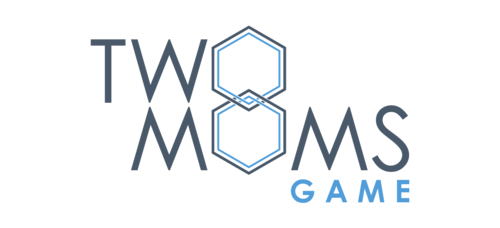
I always enjoy reading your explanations and thoughts on games. I was especially interested in your thoughts about On Mars because of the upcoming cooperative expansion (Kickstarter in May, I hope!?). It definitely sounds complex. Currently our brain burniest (totally not a word) game is Spirit Island, though we’re planning on getting Anachrony soon. We tend to like cooperative games best, hence our interest in the co-op expansion, though I was interested in On Mars regardless of the expansion. Thanks for another great review!
Pingback: Board Game Review: Three Sisters - Two Moms Game